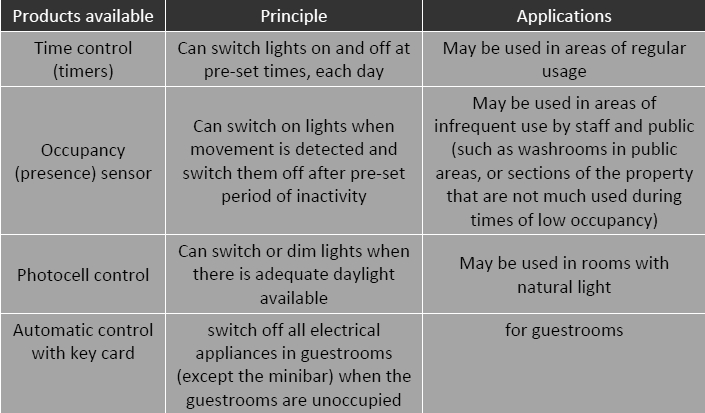Potential savings can be achieved with lighting controls, or occupancy‐linked controls. Lighting is frequently switched on unnecessarily, e.g. when there is sufficient daylight or there is nobody in the room. With manually operated systems in particular, lights tend to be left on needlessly.
It is therefore highly recommended to make the greatest possible use of occupancy‐linked controls. The principle of lighting control is to only light areas that are occupied or truly need light. This can only be achieved with technical measures, like automatic occupancy controls.
For example, in some hotels the lighting inside the guest rooms can be switched on when the guests are inside the room using a key card, and are switched off automatically when the guests leave the room, taking the key card with them.
How to proceed?
The first step is to review existing lamps and bulbs in use in the different areas of the
Hotel (rooms, floor, restaurant, outdoor area, kitchen, back office, etc.). For each of these areas, try to evaluate if it is preferable to install energy-saving light bulbs and/or
Lighting controls. In case the hotel plans to install an energy saving lamp together with lighting control, make sure that it chooses an energy-efficient lamp that works with the
Lighting control they plan to use and that the lifetime of the lamp is not influenced by extensive switching. This can be ascertained from the information provided by the manufacturer of the lamp.
Key card systems
Key card systems allow electricity to be switched off automatically when guest rooms are vacated, thus avoiding needless consumption of electricity (e.g. from TVs and lights).
The principle of key card systems is as follows: when the client inserts the key card into the energy saving device while entering the room, electricity is turned on; when the client leaves the room and retrieves the key card, electricity is shut off.
For this to function, the relevant electrical circuits of the guestroom need to be connected to the key card system. This has to be done by a professional electrician.
How to proceed?
It is possible to keep some electric appliances (like minibars or some of the wall sockets) on even when the room is vacated. To do so, care must be taken when installing the key card system to ensure that different circuits are used for those specific appliances.
Automatic control of electricity in guestrooms according to occupancy can also be integrated in the Building Energy Management System (BEMS) of the hotel (if one is installed). In this case, the control of electricity is usually associated with the control of heating and air conditioning in the rooms. So when keys are handed in, the system shuts down heating and power systems.
When is it best to install a key card system?
Due to the wiring equirements to interface the key card system to the relevant electrical circuits of the guestroom, it is best to install a key card system when renovating the electrical circuits of the guestrooms.

Environmental benefits
Installation of occupancy linked controls can save from 20% to 30% on guest room energy bills.
Cost effectiveness
Occupancy sensor: may vary from 75€ (automatic sensor for an incandescent lamp) to 125€ (for a fluorescent lamp and/or for a more complex system). Approximate payback period is between 1-8 years, depending on the installed equipment. The larger the hotel, the shorter the payback period is.